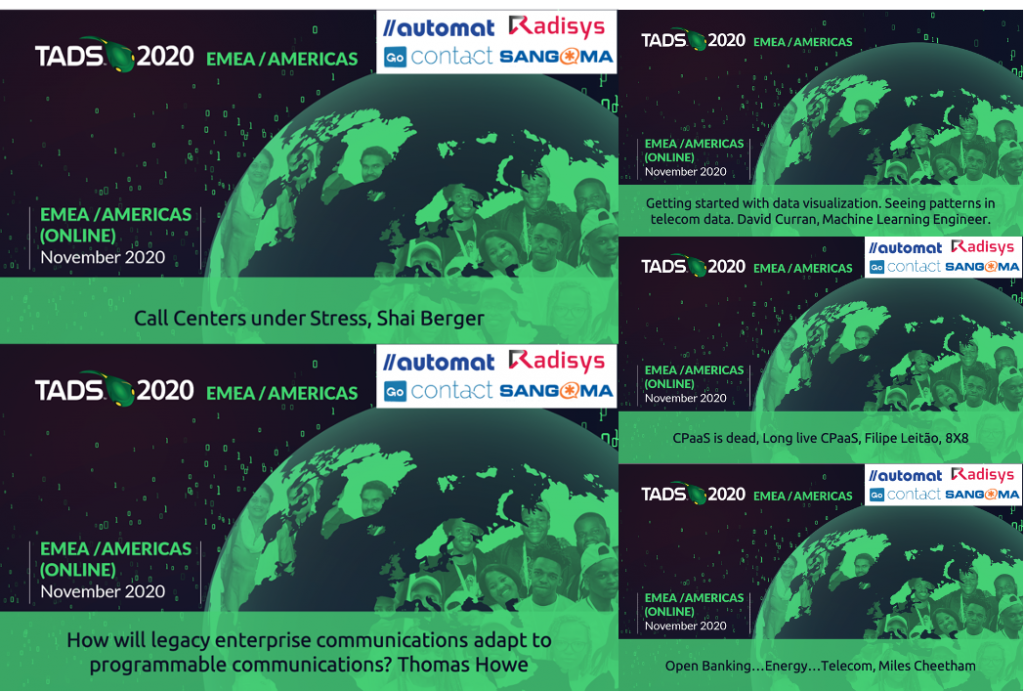In this series of weblogs, A Slice of TADSummit, we review some of the important themes from TADSummit EMEA Americas 2020. This slice focuses on Programmable Communications Potpourri.
Thank you to all the presenters and our sponsors: Automat Berlin, GoContact, Radisys, and Sangoma for making TADSummit possible.
By Potpourri, I’m not meaning a mixture of dried flowers in a bowl, rather a mixture of interesting presentations from TADSummit EMEA Americas 2020.
Call Centers under Stress, by Shai Berger, Fonolo
Shai reviews a number of headlines as call centers operated through the pandemic. He highlights the lack of metrics to determine relative success during a pandemic / crisis. For an industry obsessed with metrics in the steady-state, to not have crisis metrics is unusual, power companies and airlines have such metrics.
Communications is critical infrastructure. With power outages during a hurricane we have outages reporting with an estimate to repair. Throughout the pandemic we’ve lacked reporting on how the industry did, and Shai’s presentation addresses this important gap.
Shai reviews a number of crisis metrics, for example, how fast should a call center return to normal after a shock? He focuses on a real world case study from New Zealand. Its an impressive case, and I high recommend listening through Shai’s review.
At 2:30PM on 23rd March 2020 the Prime Minister of New Zealand announced a national lockdown, and new benefits for those made unemployed. About 75% of working New Zealanders went through this call center.
In the 3 hours after that address the traffic jumped by a factor of 5! It took about 4 months before the call volumes returned to normal, and during the crisis they had a state of the art system, and were able to triple the number of agents, as well as many other migitations. Some of the challenges included a concurrency limit on the voice IVR. Shai will be reviewing this case study in more detail over the coming months at Fonolo.com
Open Banking…Energy…Telecom. Miles Cheetham, Developing the data infrastructure to help deliver a net-zero future
Last year Miles gave an excellent presentation at TADSummit EMEA 2019 on challenges and opportunities facing the banking industry, while he was Head of Propositions at OPEN BANKING. In this presentation he reviews the success of open banking, with 273 new providers (think 3rd party developers) with over 2 million customers. I’m a fan of what Miles has achieved in Open Banking as a template for open telecoms.
How will legacy enterprise communications adapt to programmable communications? Thomas Howe, Chief Technology Officer at VHT
This is an excellent strategic thought-leadership work. Thomas sets out the assumptions that have driven legacy enterprise communications:
- From 100 years ago, we prefer to talk. Just look at how people use their smartphones today, voice is far down the list of things to do.
- From 50 years ago, voice is voice. Or rather voice is calling. Voice is done in context, and is often an ingredient of communications.
- From 10 years ago mobile apps will dominate enterprise:customer communications. Apart from a few exceptions, most brands’ apps are not adopted by most of their customers.
Thomas captures the state of the art in contact centers well, with some choice phrases.
- CCaaS is doing exactly what it says, putting the legacy contact center in the cloud to save costs.
- Enterprises are avoiding voice investments as its expensive compared to messaging investments, agents can serve more concurrent messaging customers.
- Automation is the snake oil of 2020 (I really like this phrase). Voice is here to stay, as even offshoring delivered an inferior customer experience product, so how will a computer do better?
Thomas and I are aligned on the ‘scorpion DNA’ of social media for customer communications. Social media should not be at the core of a brand’s customer data / communications strategy. Did I mention you should not be using Facebook ?
Thomas wraps up on where CPaaS needs to evolve, beyond the atomic communication actions and into conversations and sessions, which is where the data is collected. Joined up thinking across an enterprise’s business processes, workflows, customers, and support. This is an important sign-post on the evolution of CPaaS.
CPaaS is dead, Long live CPaaS. Filipe Leitão, EMEA Solutions Engineer, 8X8
In this presentation Filipe covers:
- Brief history of CPaaS (Communications Platform as a Service) since VAS (Value Add Service) times.
- It’s not about winning the developer anymore. Or viewed another way, how everyone tries to be what Twilio was 5 years ago.
- Be where your customers are: CCaaS, UCaaS and CPaaS are becoming one. It’s all just programmable communications.
Getting started with data visualization. Seeing patterns in telecom data. David Curran, Machine Learning Engineer
This is a great primer on how to plot all the data we have access to in programmable communications like a hardcore data scientist. Dave provides guidance on where to find data (not just telecoms stuff), and the tools to play with the data, like Joyplots. He shares his journey in plotting music data, e.g. the change in bpm (beats per minute) and loudness of music over the past century. Using a number if communities to get advice and support in its presentation.
The quote from Clark Terry (Jazz Trumpeter) of ‘imitate, assimilate, innovate’ is true universally. But for plotting it really does ring true. So copy Dave and build on this work. He wraps up with some of his experiences in telecom data, where I think we’re only just scratching the surface on the understandings possible. The Twilio / Segment deal will look stone-age soon, paying so much for collecting data was so 2010s ? It’s the plotting that matters!

